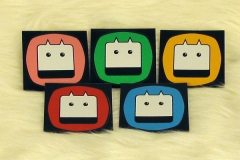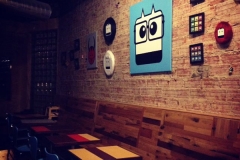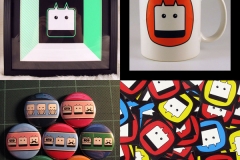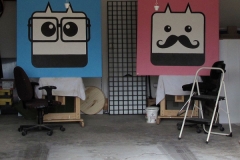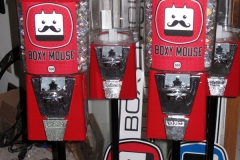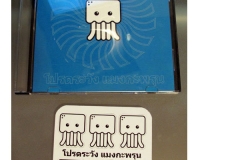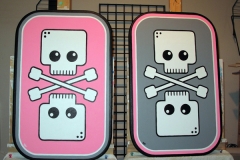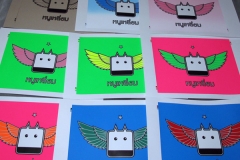An Interview with Boxy Mouse
 by Benjamin Davis Brockman
by Benjamin Davis Brockman
October 1, 2012
Sometime in the days following Northern Spark (a city-wide Twin Cities media arts festival) I was walking through the courtyard of the Minneapolis Institute of Arts. As usual, I was running late for something, and my eyes were darting frantically from spot to spot, keeping my stride in check with my busy brain, when they passed over something that gave cause to stop and ponder. On a lower leg of a metal park bench, I noticed a blue square, which was somehow so obvious in placement that it was completely obscure. It wasn’t a sticker – I’d gotten pretty savvy at picking those out by then, but upon approach, I found something a touch better. I always lament the position of liking a sticker to the point that I’m tempted to peel it, but to my chagrin, this was a plastic magnet with a jellyfish represented in a minimal, almost handicap parking graphic style. At first I just stopped and admired it. I got all the way to the car, about a block away. Then I went back and ganked it. I’m glad I did. On the back was the website enlightening me to the ways of Boxy Mouse.
Until I got home and Googled the name, I wasn’t sure if this plastic square was just the detritus of some damn Northern Spark techno art thing. And even at that, I wasn’t sure if it was okay to take it home and place it on my fridge (where it still proudly hangs today). It looked harmless enough but somehow suspicious enough to contain some kind of homing beacon or release a noxious gas. And I figured there would be some justice to that scenario. I kept seeing other sticker artists and friends posting pictures to Instagram of the Boxy magnets they acquired, and my curiosity grew. Months later, I was talking to Biafra Inc. and asked him if the magnets were intended as freebies. He assured me that this was the point.
Shortly thereafter, upon walking into Longfellow’s Peace Coffee I saw a gumball machine filled with variations of the Boxy design on buttons. By the time I ran across a screen print of Boxy Mouse at Northwest Graphic Supply and had seen the likeness slapped on the back of many a stop sign elsewhere in the Metro, I was chomping at the bit to find out more about the phenomenon. I contacted the creator directly, eager to find out how this super minimal character had become a full-on franchise. Boxy is a fixture on the streets of the Twin Cities, as well as in galleries and exhibitions, with a growing web following and exponentially expanding catalog of Boxy Merchandise. But what the fuck is it, really? It seems overtly simple and silly, but by it’s very nature, with it’s debt to Popism, Kitsch and it’s likeness to the minimal graphics used designate the gender of public bathrooms, it also seems loaded with a self-aware sarcasm. The fact that Boxy has been such a hit, and will undoubtedly continue to be, isn’t at all surprising. The character and its spirit are so unabashed and so damn congenial and cute that it’s impossible not to smile when you see its beady eyes darting out at you.
At his own request, the subject of this interview shall be referred to as “The Unopposed Boxy Mouse Employee of the Month.” Although he is not referred to directly in anyway necessitating this disclaimer: We both feel that it is important to stress that Boxy Mouse is the real star here.
The Fiddleback: How did Boxy Mouse come into being? Why a mouse? Why boxy?
BOXY: It all started as a silly cover design for a CD “mixtape” in 2007. The image was an abstract caricature of a funny little mouse named Jasmine that I was keeping as a pet, and the “boxy” shape worked well with a CD case’s shape. For some reason I decided to do a large (4’ x 4’) painting of that same image a couple months later—it amused me because it was such a ridiculous undertaking, but had an undeniable solid “pop” quality to it. About a year later the Boxy Jellyfish design was used for another CD cover and accompanying stickers. It was becoming clear to me that this had potential to become something more, and the project was dubbed “Boxy Mouse.”
The Fiddleback: Your characters seem to have proliferated from variations on Boxy Mouse to Boxy Jelly Fish and Boxy Bees, etc. Some of your new figures aren’t even boxy at all. Where do you see all of this going? Is there a limit to what can be Boxy?
BOXY: I see this as something that the world will be familiar with by the time I am finished—a universal icon. Of course that is going to require continuing work, patience, sacrifice, inspiration etc. I feel almost silly laying it out like that, but it is how I see it going down.
At this time, there is a self-imposed limit to what can be Boxy—very rarely is a new character introduced. It is a conscious effort to make sure the project is as focused as possible while still keeping the output interesting. A diluted product would make no sense at this point. Plus, I don’t want to connect easy dots for people. Let’s say “Boxy Cat” was introduced … that would make sense. I do not intend for things to make sense in a conventional way.
I’ve always been pretty sensitive about “selling out.” […] I guess the real challenge is making things I am happy with that will also catch on commercially with a wide audience.
The Fiddleback: Do you ever feel confined by the format you’ve created? Will Boxy ever be a burden to your muse?
BOXY: I do not feel confined at this point. There are still many more avenues to explore—more materials, bigger shows, different products. It’s still a complete joy, and my muse is fully stoked.
The Fiddleback: Your twitter page consists of a single tweet from April 2011: “A big hello to my one follower. Really only on here to hold the name. Had a cookie for breakfast.” On the other hand your Facebook page is blowing up. What role does social media play for you? Do you think it can be a significant tool for an artist?
BOXY: I have a sort of double-edged view of social media. It is really cool to let people know what you’re up to with a single post, but the most important thing for me is actually making things, not talking about it. The Twitter account might reawaken at some point, but how many times would “Painted, printed and made buttons all day” be an interesting tweet? Facebook seems to be the one that makes the most sense to participate in, and I really only have time for one outlet right now. In fact, updating the Boxy Mouse blog should be top of the list, but that is also tricky to keep up with when it is a tiny operation.
The Fiddleback: You encourage Boxy sightings to be photographed and sent in to an email address posted on your website and fb page. Do you think all of this would be possible before the smart phone? How would an ongoing project like this be different before Instagram, Tumblr—or the internet in general?
BOXY: The “Boxy Sightings” were something I was keeping up with in 2009, but not so much today. One of the lovely things about Facebook (and Instagram, Tumblr, etc.) is the ability for someone who is new to Boxy Mouse to easily experience all those photos like it is the first time. That would not be possible before the internet.
Coincidentally, I got a picture today that was worth posting—I certainly do not discourage the pictures, but they have to be pretty sweet to really get my attention these days. By all means, keep sending them!
The Fiddleback: Your process is intriguing in the sense that much of what you create seems to be given freely to the world at large. In the case of your magnets for example, I understand it is your hope that these will be taken to the homes of those who discover them?
BOXY: I try to give away as much as is possible while still attempting to make a living. I’d love to say it is some kind of genius marketing strategy I am employing, but it’s probably more of a “Look at what I can do!” attention grab. Thousands of buttons and stickers have been given away over the years, and it has been totally worth it—I’ve had tons of cool little social interactions with people that otherwise would not have happened.
To be honest, the street magnet art is not an original idea. There’s an artist I came into contact with named Kenn Twofour who organizes something called Free Art Friday in Atlanta (FAFATL). When I saw what he was doing, I put my own spin on it and started putting them around the Twin Cities – it was a nice addition to the stickering I was already doing.
The Fiddleback: Street art has a really broad conceptual definition, but your work seems to do something really different in the way it engages society. Do you see it as street art? To what extent do you see the Boxy Mouse phenomenon as a social experiment?
BOXY: I don’t think I’ve done enough work on the streets to be considered a full-on street artist, but I sure do enjoy participating and I consider it a critical part of the operation. It is surprising how many people know Boxy Mouse from what they see on the street. One of my top goals is to engage as many people as possible—all ages and social standings. The street activity helps reach a different bunch of enjoyable humans.
The Fiddleback: Do you think there is any part of your work that is satirical in the way it approaches the ideas of fine art and consumerism, or even material culture in general?
BOXY: I’m not so sure if it is as much satirical as silly. Personally, it is such a weird combination of dead-serious and complete nonsense, like life in general I suppose.
I majored in advertising in college and worked in the print industry for two decades after that. These experiences made me acutely aware that the nature of mass communication in America is largely a call to consume. Not only that, the consumer is told exactly what they see and how to feel about it! I try to take a different path. The Boxy characters have a lot of blanks that need to be filled in by the viewer, and I am fairly careful to not tell people what they are looking at or how they feel about it. They need to work it out for themselves. I love seeing people of all ages make these connections for themselves. So much of what is offered to society is spoon-fed, and I try to avoid that. That being said, I would also like to make money so it can keep going – it conflicts at times. It gets fuzzy. Is it art or product? Does it matter?
The Fiddleback: You seem incredibly resourceful. Without showing too much of your hand, can you describe how you go about locating gumball machines and other paraphernalia you employ? Is there a strategy to approaching a business where you really want to house a machine?
BOXY: I suppose I am fairly resourceful. Whether it is screen-printing, building and stretching canvases, framing, making buttons, die cutting, etc., I have a compulsion to make things.
The “Boxy Mouse Button Dispensaries” (gumball machines) have been a wonderful little surprise. When I bought my first machine (via eBay) it was more of a personal design puzzle than a money-making endeavor. I now have 8 of them dispensing buttons around the Twin Cities, and I’m going to place an order for a few more any day now—it is one of the coolest parts of the project. The vending machine placement is a touchy subject for me. I like to have some kind of relationship with the place first, usually this comes from having Boxy Mouse paintings and prints on their walls for one reason or another. This way people already have a sense of what Boxy Mouse is about, and know that I’m not a scummy opportunist uncaringly plopping a machine into their environment.
The Fiddleback: Would you say that your commercial ventures are distinct in any way from your creative practice? How do you define success in either category?
BOXY: This is the age-old struggle of artists. It is so difficult to make a real living and keep things true to your intentions. That being said, that’s exactly what I’m trying to do. I’ve always been pretty sensitive about “selling out.” The trick is not to let that sabotage things. I guess the real challenge is making things I am happy with that will also catch on commercially with a wide audience. I currently have some smaller things in the Walker Art Museum shop, and it is a great situation—I did not have to compromise at all. I am on the lookout for more of those types of opportunities for sure.
The Fiddleback: Who are some of your heroes? What gets you excited in art, music, pop culture, etc?
BOXY: There are certainly a bunch of humans who make visual stuff that I admire. Erin Currie (Curster), Jeral Tidwell, James Marshall (Dalek), Clay Ferguson (FERG), Jonathan Bergeron (Johnny Crap), Jason Goad and dozens of others who I can’t think of right now are making excellent stuff that keeps me engaged and inspired. Obviously, Japanese design (contemporary and historic) has had a big effect on Boxy Mouse—I can’t get enough of the heavy outlines. Salvador Dali has always been a favorite of mine as well. There is something so great about a person whose work is well outside of societal norms but who has the undeniable talent to make it succeed globally.
Music is a big part of what drives me. There have been times where I don’t feel like grinding through another day in front of a canvas or dragging a squeegee across a screen hundreds of times, and then the tunes start and I’m fully into it once again. It would be impossible to list all the cats that make the music I enjoy, but I’ll name a few. First and foremost is Dillinger Four—I’m not exactly sure how their music became so dear to me, but when they are in my ears good things are undoubtedly happening. I’ve also been big into Combichrist and Silversun Pickups lately. There’s a band called Kvelertak that I recently latched onto that has a killer album. Also, Baroness has a new one that is pretty great (Baroness guitarist/singer John Baizley is also a fantastic visual artist). Let’s stop right there, or this could easily turn into a “What Music Does The Boxy Mouse Dude Like?” article.
The Fiddleback: What’s on the horizon? Is there anything you want to try with Boxy, or otherwise?
BOXY: The number one priority is to keep on producing interesting paintings, prints and whatnots for shows—hopefully they will be things people want to buy, but that is a secondary concern. I spent the summer of 2012 working on Boxy Mouse exclusively. It was a happy time indeed, and I would like to keep it going. Therefore, an important goal is to keep working on Boxy Mouse 24/7 and make a living at it. Moving into 2013, there is going to be more emphasis on retail endeavors (anyone who thinks Boxy Mouse would fit into their store can send an email to mail[at]boxymouse.com). I would also like to get another half-dozen gumball machines out there in the next few months. Artistically, in addition to the usual paintings and screen prints, I’ve been dabbling with what the characters look like in three dimensions, and how to bring that to the real world. This opens up a whole bunch of new possibilities—vinyl figures, plush objects, furniture etc. There is so much left to explore with this cast of characters. A strange fixation of mine is to manufacture Boxy Mouse pajamas. Also, some sort of animation seems inevitable—probably with some sort of funny non sequitur flavor.
Vive le Boxy Mouse!
——–
boxymouse.com
